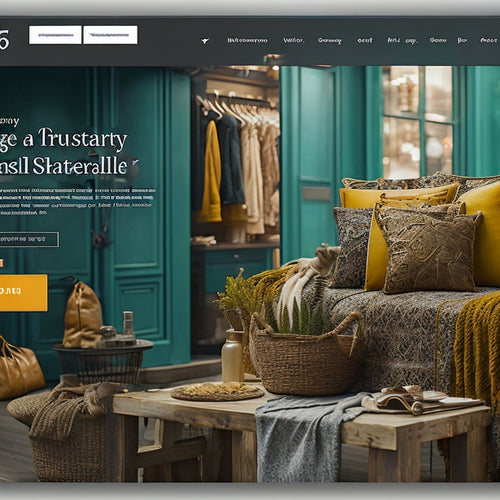
3 Essential Tools for Ecommerce Online Course Success
Share
You're just three essential tools away from transforming your ecommerce online course into a engaging, efficient, and effective learning experience that drives real results for your students. To build engaging learning experiences, you'll need a tool that lets you create interactive modules and quizzes. For a streamlined course creation process, invest in a template-based video creation tool and a course outline builder. To cap it off, to measure student progress effectively, utilize a data analysis tool to track progress and identify areas of struggle. Now, discover how to put these tools into action to take your course to the next level.
Key Takeaways
• Invest in a Learning Management System (LMS) to streamline course creation, deployment, and tracking of student progress.
• Utilize interactive video creation tools with templates to craft engaging and informative course content.
• Leverage AI-powered assessment and feedback tools to provide personalized guidance and immediate feedback to students.
• Implement collaborative project management tools to facilitate teamwork and efficient course development.
• Analyze student feedback and course performance data to refine course content and improve learning outcomes.
Building Engaging Learning Experiences
To captivate your students and drive meaningful learning outcomes, you need to craft an ecommerce online course that's both informative and entertaining, with lessons that flow seamlessly and hold their attention from start to finish. This means incorporating interactive modules that encourage participation, stimulate discussion, and foster a sense of community.
For instance, you can create quizzes, games, or simulations that test students' knowledge and skills, while providing immediate feedback and guidance. Moreover, offering personalized feedback is essential in helping students identify areas for improvement and track their progress. This can be achieved through automated assessments, peer reviews, or even AI-powered feedback tools.
Streamlining Course Creation Process
With your engaging learning experience designed, you're now ready to focus on building your ecommerce online course efficiently, saving time and resources by streamlining your course creation process. This is where the rubber meets the road, and you turn your course design into a tangible product.
To streamline your course creation process, consider the following essential tools:
-
Template-based instructional video creation: Invest in a video creation tool that offers pre-built templates, allowing you to quickly create high-quality instructional videos that align with your course design.
-
Course outline builders: Utilize a course outline builder to organize your content, ensuring a logical flow of information and reducing the time spent on reorganizing your material.
-
Collaboration and project management tools: Leverage tools that enable seamless collaboration with your team, allowing you to assign tasks, track progress, and meet deadlines, all in one place.
Measuring Student Progress Effectively
You'll want to establish a clear system for measuring student progress effectively, as this insight will help you refine your course content and guarantee learners are achieving their goals.
By tracking student progress, you'll be able to identify areas where students are struggling, and make adjustments to your course content accordingly. This is where data analysis comes in – by analyzing student performance data, you'll be able to pinpoint specific areas that need improvement.
Additionally, collecting student feedback through surveys, reviews, or one-on-one check-ins will provide valuable insights into what's working and what's not. This feedback will help you refine your course content, making it more engaging and effective for your students.
Frequently Asked Questions
Can I Reuse Content From My Existing Website or Blog for My Course?
Did you know 60% of online course creators struggle with content creation? You can breathe a sigh of relief - you can reuse content from your existing website or blog, but be cautious of plagiarism and guarantee copyright protection to prevent sharing without permission.
How Do I Protect My Course Content From Being Stolen or Shared?
To safeguard your valuable content, you'll want to ponder copyright protection, watermarking your visuals, and securing your hosting with access control measures in place, ensuring only authorized learners can access your course materials.
What Is the Ideal Length for an Ecommerce Online Course?
"Imagine a juicy novel - you don't want it to be too short or too long, right? Similarly, your ecommerce course should be long enough to provide value, but short enough to keep students engaged, typically 4-6 hours, considering course pricing and market competition."
Can I Create a Successful Ecommerce Course With Little to No Budget?
You can create a successful ecommerce course with little to no budget by leveraging free marketing strategies and being resourceful with content creation, focusing on quality over quantity to overcome budget limitations.
Do I Need to Be an Expert to Create a Successful Ecommerce Course?
You don't need to be an absolute expert to create a successful ecommerce course, but having some experience and knowledge in the field will definitely boost your success rate and make course creation easier.
Related Posts
-

7 Proven Strategies to Maximize Online Course Completion
You can greatly enhance online course completion rates by implementing targeted strategies that address common drop-o...
-
The Best Shopify Apps for Sitemap Submit
This article presents an analysis of the best Shopify apps available for sitemap submission. The objective of this r...
-

Enhancing Sales: Cross-Promoting Products on Shopify
Cross-promoting products on Shopify has emerged as a powerful approach to bolster sales and improve the overall cust...

